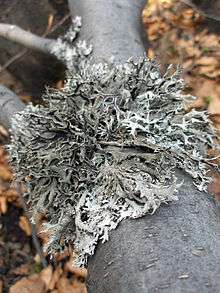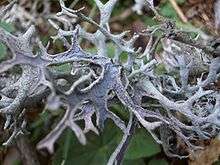Pseudevernia furfuracea
Pseudevernia furfuracea, commonly known as tree moss, is a lichenized species of fungus that grows on the bark of firs and pines. The lichen is rather sensitive to air pollution, its presence usually indicating good air conditions in the growing place. The species has numerous human uses, including use in perfume, embalming and in medicine. Large amounts of tree moss is annually processed in France for the perfume industry.
| Pseudevernia furfuracea | |
|---|---|
 | |
| Scientific classification | |
| Kingdom: | Fungi |
| Division: | Ascomycota |
| Class: | Lecanoromycetes |
| Order: | Lecanorales |
| Family: | Parmeliaceae |
| Genus: | Pseudevernia |
| Species: | P. furfuracea |
| Binomial name | |
| Pseudevernia furfuracea | |
| Synonyms | |
| |
Description
Pseudevernia furfuracea is associated with photobionts from the green algae genus Trebouxia.[1] It reproduces asexually by isidia.[2] The ontogeny of isidia development and its role in CO2 gas exchange in P. furfuracea has been investigated.[3] The preferred growing surfaces for P. furfuracea are the so-called "nutrient poor" bark trees, including birch, pine and spruce.[4]
The species has two morphologically identical varieties that are distinguished by the secondary metabolites they produce: var. ceratea Zopf. produces olivetoric acid and other physodic acids, while var. furfuracea produces physodic but not olivetoric acid. Some authors (e.g., Hale 1968[2]) have separated the chemotypes at the species level, designating the olivetoric acid-containing specimens as Pseudevernia olivetorina, but more recent literature separates them at the varietal level.[5]
Uses
Perfumes
Large amounts of tree moss (approximately 1900 tons in 1997) are processed in Grasse, France for the perfume industry.[6]
Embalming
In ancient Egyptian embalming, P. furfuracea was found packed into the body cavity of mummies,[7][8] although it is not certain whether this was done because of the supposed preservative properties or the aromatic properties of the lichen.[9]
Antimicrobial activity
Soluble extracts from P. furfuracea var. furfuracea and var. ceratea, as well as specific compounds found therein, have antimicrobial activity against a variety of microorganisms.[10]
Medicinal use
In Alfacar and Viznar, Andalucia (Spain), P. furfuracea is used for respiratory complaints. The thallus is washed and boiled for a long time to prepare a decoction which is drunk.[11]
Water extracts of this species have been shown to have a potent protective effect on genotoxicity caused by bismuth compounds such as colloidal bismuth subcitrate.[12]
Heavy metal sorption
Pseudevernia furfuracea has been investigated for its ability to absorb heavy metals from solution. The metal-binding biosorption for copper(II) and nickel(II) was shown to follow the Langmuir and Freundlich isotherm models, suggesting it may have potential as a biosorbent for treatment of heavy metal wastes.[13]
Pollution monitors

Because specimens of P. furfuracea tend to bioaccumulate heavy metals like Cr, Zn, Cd, Pb, Ni, Fe, Mn and Cu proportional to their concentration in airborne particulates, they may be used as a biomonitor of air quality,[14][15][16] although it has been noted that both trace metal accumulation[17] and major element accumulation[18] is partly dependent on the hydration level of the specimen. Also, the species is sensitive to ozone concentrations: ozone fumigation results in biophysical, physiological, and structural impairment of specimens.[19] P. furfuracea has also been used to monitor the levels of radionuclides such as Cesium-137 in Austria after the Chernobyl nuclear accident.[20]
Bioactive compounds
In addition to the physodic acid mentioned above, P. furfuracea also contains 2-hydroxy-4-methoxy-3,6-dimethyl benzoic acid,[21] atranorin, oxyphysodic acid, and virensic acid.[22] Of these compounds, atranorin showed the highest inhibition of proteolytic enzymes trypsin and porcine pancreatic elastase.[22] Research suggests that the biosynthesis of both atranorin and physodic acid is influenced by the cooperation of epiphytic bacteria.[23]
A number of sterol compounds have been identified from P. furfuracea, including ergosterol peroxide, ergosterol and lichosterol.[24]
References
- Kranner, I. (2002). "Glutathione status correlates with different degrees of desiccation tolerance in three lichens". New Phytologist. 154 (2): 451–460. doi:10.1046/j.1469-8137.2002.00376.x.
- Hale, ME. (1968). "A synopsis of the lichen genus Pseudevernia". The Bryologist. 71 (1): 1–11. doi:10.2307/3240645. JSTOR 3240645.
- Tretiach M, Crisafulli P, Pittao E, Rinino S, Roccotiello E, Modenesi P. (2005). Isidia ontogeny and its effect on the CO2 gas exchanges of the epiphytic lichen Pseudevernia furfuracea (L.) Zopf. Lichenologist 37(5): 445–462.
- "sh.diva-portal.org". Retrieved 2008-12-19.
- Halvorsen, R; Bendiksen, E. (2008). "The chemical variation of Pseudevernia furfuracea in Norway". Nordic Journal of Botany. 2 (4): 371–380. doi:10.1111/j.1756-1051.1982.tb01202.x.
- Joulain, D; Guillamon, N. (2002). "Pseudevernia furfuracea ("treemoss") resinoid in fragrance compounding: Analytical issues". Koryo, Terupen Oyobi Seiyu Kagaku Ni Kansuru Toronkai Koen Yoshishu. 46: 16–18.
- Club, Torrey Botanical (1882). Bulletin of the Torrey Botanical Club - Google Book Search. Retrieved 2008-12-19.
- Nicholson, Paul T; Shaw, Ian (2000). Ancient Egyptian Materials and ... - Google Book Search. ISBN 978-0-521-45257-1. Retrieved 2008-12-19.
- Baumann, BB. (1960). "The Botanical Aspects of Ancient Egyptian Embalming and Burial". Economic Botany. 14 (1): 84–104. doi:10.1007/BF02859368.
- Türk H, Yılmaz M, Tay T, Türk AÖ, Kıvanc M. (2006). Antimicrobial activity of extracts of chemical races of the lichen Pseudevernia furfuracea and their physodic acid, chloroatranorin, atranorin, and olivetoric acid constituents. Z. Naturforsch. 61c:499–507. PDF
- González-Tejero, MR; Martínez-Lirola, MJ; Casares-Porcel, M; Molero-Mesa, J. (1995). "Three Lichens Used in Popular Medicine in Eastern Andalucia (Spain)". Economic Botany. 49 (1): 96–98. doi:10.1007/BF02862281.
- Geyikoglu F, Turkez H, Aslan A (September 2007). "The protective roles of some lichen species on colloidal bismuth subcitrate genotoxicity". Toxicol Ind Health. 23 (8): 487–92. doi:10.1177/0748233708089044. PMID 18669170.
- Ates, A; Yildiz, A; Yildiz, N; Calimli, A. (2007). "Heavy metal removal from aqueous solution by Pseudevernia furfuracea (L.) Zopf". Annali di Chimica. 97 (5–6): 385–393. doi:10.1002/adic.200790023. PMID 17696016.
- Bari A, Rosso A, Minciardi MR, Troiani F, Piervittori R (July 2001). "Analysis of heavy metals in atmospheric particulates in relation to their bioaccumulation in explanted Pseudevernia furfuracea thalli" (PDF). Environ Monit Assess. 69 (3): 205–20. doi:10.1023/A:1010757924363. PMID 11497378. Retrieved 2008-12-18.
- Jozic M, Peer T, Türk R (April 2008). "The impact of the tunnel exhausts in terms of heavy metals to the surrounding ecosystem". Environ Monit Assess. 150 (1–4): 261–71. doi:10.1007/s10661-008-0228-3. ISSN 0167-6369. PMID 18415694.
- Sorbo S, Aprile G, Strumia S, Castaldo Cobianchi R, Leone A, Basile A (December 2008). "Trace element accumulation in Pseudevernia furfuracea (L.) Zopf exposed in Italy's so called Triangle of Death". Sci. Total Environ. 407 (1): 647–54. doi:10.1016/j.scitotenv.2008.07.071. PMID 18835631.
- Adamo P, Giordano S, Vingiani S, Castaldo Cobianchi R, Violante P (2003). "Trace element accumulation by moss and lichen exposed in bags in the city of Naples (Italy)". Environ. Pollut. 122 (1): 91–103. doi:10.1016/S0269-7491(02)00277-4. PMID 12535598.
- Vingiani S, Adamo P, Giordano S (May 2004). "Sulphur, nitrogen and carbon content of Sphagnum capillifolium and Pseudevernia furfuracea exposed in bags in the Naples urban area". Environ. Pollut. 129 (1): 145–58. doi:10.1016/j.envpol.2003.09.016. PMID 14749078.
- Scheidegger C, Schroeter B (1995). "Effects of ozone fumigation on epiphytic macrolichens: ultrastructure, CO2 gas exchange and chlorophyll fluorescence". Environ. Pollut. 88 (3): 345–54. doi:10.1016/0269-7491(95)93449-A. PMID 15091548.
- Heinrich, G; Oswald, K; Muller, HJ. (1999). "Lichens as monitors of radiocesium and radiostrontium in Austria". Journal of Environmental Radioactivity. 45 (1): 13–27. doi:10.1016/S0265-931X(98)00069-1.
- Kirmizigul, S; Koz, M; Anil, H; Icli, S; Zeybek, U. (2003). "Isolation and structure elucidation of novel natural products from Turkish lichens". Turkish Journal of Chemistry. 27 (4): 493–500.
- Proksa B, Adamcová J, Sturdíková M, Fuska J (April 1994). "Metabolites of Pseudevernia furfuracea (L.) Zopf. and their inhibition potential of proteolytic enzymes". Pharmazie. 49 (4): 282–3. PMID 8197230.
- Blanch M, Blanco Y, Fontaniella B, Legaz ME, Vicente C (2001). "Production of phenolics by immobilized cells of the lichen Pseudevernia furfuracea: the role of epiphytic bacteria". Int. Microbiol. 4 (2): 89–92. doi:10.1007/s101230100019. PMID 11770830.
- Wojciech, ZA; Goad, LJ; Goodwin, TW. (1973). "Sterols of lichen Pseudevernia furfuracea". Phytochemistry. 12 (6): 1433–1436. doi:10.1016/0031-9422(73)80579-5.
| Wikimedia Commons has media related to Pseudevernia furfuracea. |